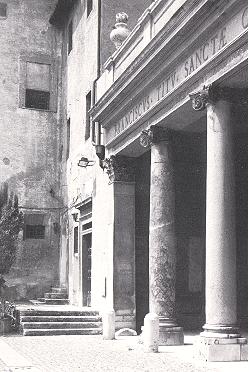 |
 |
 |
 |
 |
 |
 |
 |
 |
|
A Jacobite Gazetteer - Rome
Convento di Santa Cecilia in Trastevere
To the left of the entrance to the Basilica di Santa Cecilia in Trastevere is the entrance to the convent of the same name. It was here that Queen Clementina retired in November 1725 when she disputed with King James III and VIII over the religious upbringing of the Prince of Wales (later King Charles III). Clementina remained at the convent until July 1727. According to the Marchesa Vitteleschi, there were formerly several memorials of Queen Clementina in this convent. 1 The present Mother Superior (2001) does not know the whereabouts of these memorials; the convent has been restored several times, and they may have been removed. The Marchesa Vitteleschi writes that there was an upstairs chapel in a small alcove of which could be found the prie-Dieu of Queen Clementina. A small opening in the wall with an iron grating overlooked the church below; this permitted Queen Clementina to participate in the liturgy unobserved. An inscription attested to Queen Clementina's presence: |
|
HOC IN SACELLO
M. CLEMENTINA SVBIESCHI MAGNÆ BRITANNIÆ REGINA AB ANNO MDCCXXV MENSIBVS XIX DIEBVS XXIII MANE, VESPERE, ALIISQVE HORIS, ABINDE QVOAD VIXIT SEMEL SALTEM IN HEBDOMADA ORARE CONSVEVIT. In this chapel Maria Clementina Sobieska, Queen of Great Britain, was accustomed to pray matins, vespers, and the other hours, for nineteen months and 23 days, at least once a week from 1725 as long as she lived. |
|
A second inscription could be found in a small dormitory leading out of the long refectory:
In the long refectory under the window that looks out on the convent orchard was another inscription:
IACOBI. III. MAGNAE BRITANNIAE REGIS CONIUGI QVOD ANGVSTAS HASCE AEDES HOSPES AMPLISSIMA DIV INCOLVERIT ET OMNIBUS QVAE IN HAC SACRA DOMO SVNT RELIGIONE PIETATE AC INNVMERIS VIRTVTUM EXEMPLIS ASSIDVE PRAELVXERIT ABBATISSA ET COENOBIJ MONIALES PERENNIS EARVM OBSEQUIJ ET ANIMI DEVINCTISSIMI TESTEM MONUMENTVM POSVERE ANNO DOMINI MDCCXXVII To Clementina Sobieski wife of James III, King of Great Britain, who as a most illustrious guest lived in this enclosed house for a long time and in the things which took place in this holy house was always outstanding in religious devotion and in innumerable examples of virtue: the abbess and cloistered nuns placed [this] monument as a testimony of their perpetual homage and of their most devoted affection in the year of our Lord 1727. This last inscription was purchased in October 1979 from an antique store by Fabrizio M. Apollonj Ghetti. 2 I have not been able to determine its present location. One can obtain an idea of the type of room in which Queen Clementina resided if one takes the guided tour of the nun's choir in order to see the 13th century fresco of the Last Judgement by Pietro Cavallini. From this room within the cloistered part of the convent one can look through an iron grating to the church below, just as Queen Clementina would have been able to do. The brief tour leaves daily at 10.00 a.m.; a small offering should be made. Notes 1 Amy Vitteleschi, A Court in Exile: Charles Edward Stuart and the Romance of the Countess d'Albanie (London: Hutchinson, 1903), I, 135-138. 2 Fabrizio M. Apollonj Ghetti, "Pietà per Clementina", Bollettnio dei Curatores dell' Alma Città di Roma anno VI, numero 26 (Giugno 1979), item 182. Ghetti describes the stone as: "una lapide in marmo bianco (m. 0,92 x 0,51), inquadrata in una cornice di marmo giallo ben sagomata, ma largamente frantumata". Image 1 (Entrance to the Convento di Santa Cecilia): Luciano Tubello, Restauri a Roma: Santa Cecilia, Villa Doria Pamphili, Sant'Eusebio (Rome: Editalia, 1988), 39.
This page is maintained by Noel S. McFerran (noel.mcferran@rogers.com) and was last updated November 8, 2003. |
